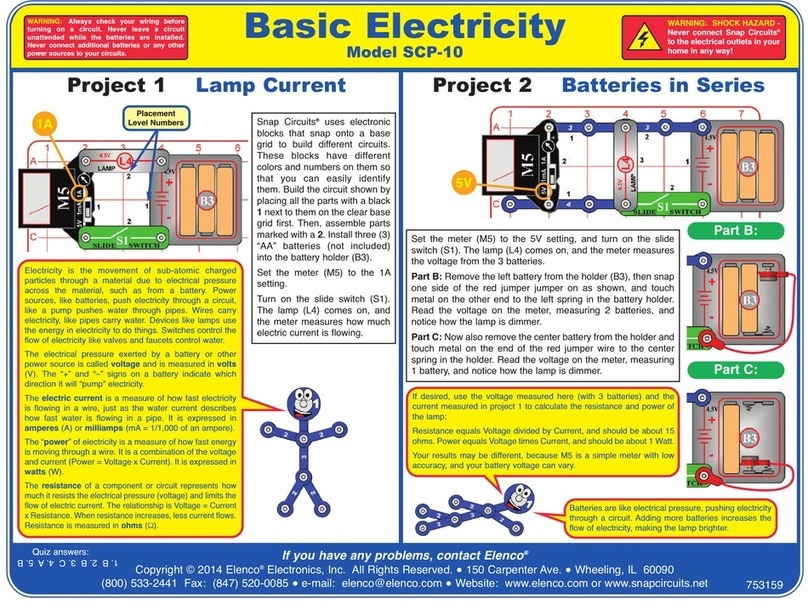
-2-
INTRODUCTION
Test your nerve with the Nerve Tester Kit. It takes a steady hand, should you touch the twisted wire with the
probe, a slight electrical shock will be felt. The shock is very weak and harmless. For the weak of heart or
“chickens” a switch removes the electrical shock and substitutes a Light Emitting Diode (LED) which lights up
when the probe touches the wire.
THEORY OF OPERATION
The circuit of the Nerve Tester is shown on page 6 of this manual. The circuit consists of two basic circuits. One
is the high voltage generator and the other the LED with its latch circuit. We shall study each circuit further.
THE LED CIRCUIT
Figure 1 shows the basic LED circuit. Note that the battery is placed in a
series circuit with resistor R1, the LED and the Silicon Controlled Rectifier
(SCR). The positive voltage of the battery is placed on the anode of the SCR.
The negative voltage is connected to the cathode. Under these conditions if
a positive voltage is placed on the gate of the SCR, even for a 1/1000 of a
second, the SCR will conduct current and keep conducting when the positive
voltage is removed from the gate. This will keep the LED lit until the voltage
is removed from the SCR. This is done by closing switch 1, which shorts out
the SCR. Resistors R1 and R2 are needed to limit the current in the LED and
SCR.
THE SHOCKER GENERATOR
Figure 2 shows the basic circuit used to produce the high voltage of the
shocker generator. The heart of this circuit is the transformer. We shall review
the operation of a transformer to understand the circuit.
A transformer has two or more windings around an iron core. If a changing
current is placed in one of the windings, it will appear in the other winding.
The voltage across the second winding will be the ratio of the turns of the
transformer. If the first winding has 100 turns and the second has 1,000 turns
(10:1 ratio) the secondary voltage will be 10 times the primary voltage. In our
transformer, the ratio is 30:1. Therefore, the 9V battery voltage will be
stepped up to 270V on the secondary.
The primary wire of the transformer is connected to the negative side of the battery. The positive side of the
battery is connected to the twisted wire. The other primary wire is connected to the probe. When the probe
touches the twisted wire, a DC current flows through the primary of the transformer. The secondary of the
transformer will only have voltage the instant the probe touches the twisted wire and the instant the probe leaves
the wire. Again, only when the current changes. Refer to Figure 3 and note that there are two voltage spikes
for each time the probe touches the twisted wire. This is because the current changes twice.
Note that the probe is double-sided copper with an insulation in between. One side is negative (ground), the
other side connects to the high voltage. Your hand touches both plates and therefore you feel the shock.
LED
R1
S1
Cathode
Gate
Anode
SCR
Wire
Probe
R2
Figure 1
T1 S2 Wire
Probe
Figure 2
Figure 3
Current in
Primary
Voltage in
Secondary
+270
–270
Max
Zero

























